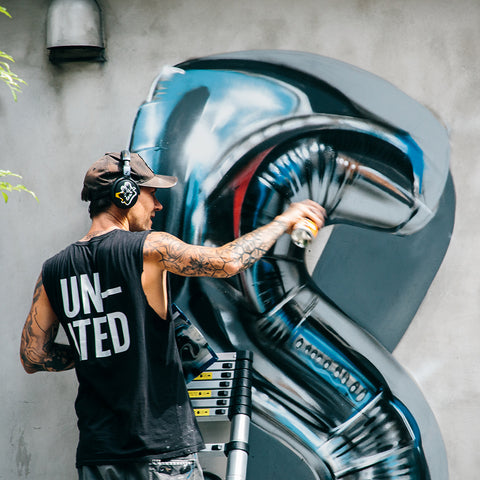We’re proud to be from a city where graffiti is celebrated as the art form that is. Street art in Brighton is some of the best in the world. From Banksy’s Kissing Coppers and Req’s handiwork on the Prince Albert Pub, to the works of street art legends, Postman, SinnaOne and Cassette Lord – Brighton is a city that knows great art when it sees it.

While it hasn’t always been recognised as such, graffiti wall art is a powerful driver of progress. Street artists aren’t just brightening dull corners of cities, they’re spreading empowering social and political messages that raise awareness and bring communities together.
Just a few decades ago, graffiti was considered the medium of a subculture of outsiders. Now this raw and expressive artform has transformed to a sought-after gem in the profile of every self-respecting art collector. In 2024, spray paint artworks can be found in museums, galleries and auction houses, as the art world continues to acknowledge the power of street art to reach the hearts and minds of the masses.
In today’s blog, we’re diving into the world of street art to see how the scene began, and how some of Enter Gallery’s most popular artists made the leap from the street to the gallery.

“Keith in the subway” (CC BY-NC 2.0) Ken Lig (JUST SHOOT IT! Photography)
A Little Background
People have been creating street art as far back as history goes, with cave paintings widely considered the earliest example of the medium. In terms of the modern scene, the history books state that it was born in Philadelphia in the USA in the early 1960s, before quickly making its way to the bright lights of New York City.
New York’s graffiti scene really took off in the 70s, during the birth of Hip Hop culture, when people began tagging buildings and trains across the city. While this started as a way for street gangs to mark their territory, with the arrival of artists like Jean Michel Basquiat and Keith Haring, street art began to grab people’s attention, and of course, art galleries started taking notice.
Interestingly, it was around this time that New York Mayor, John Lindsay, declared the first war on graffiti, turning the act from a mere misdemeanour to a felony. This meant that if graffiti artists wanted to share their art, they had to turn to alternative means, which led them to billboards, rooftops and ultimately, the canvas.
Shepard Fairey

"I consider myself an artist with an agenda to democratise art. I want to reach people through as many platforms as possible. Galleries and museums have their place but they shouldn't be the only venues for people to experience art." Shepard Fairey
Shepard Fairey was a skater who broke out onto the art scene designing and selling skateboards and t-shirts. In 1989, he launched his now infamous sticker campaign featuring a portrait of the wrestler, André René Roussimoff, and the caption, Andre the Giant Has a Posse.
His OBEY stickers gained national attention due to their ambiguous nature. People had noticed and speculation was rife about what the image meant, or what it was promoting, with many fearing the worst. Speaking of his work, Fairey revealed:
"The sticker has no meaning but exists only to cause people to react, to contemplate and search for meaning in the sticker. When I started to see reactions and consider the sociological forces at work surrounding the use of public space and the insertion of a very eye-catching but ambiguous image, I began to think there was the potential to create a phenomenon."

In the years that followed, Fairey turned his hand to guerrilla marketing, and album artwork for the likes of Led Zeppelin, The Smashing Pumpkins and The Black Eyed Peas. It was in 2008 that the mainstream caught onto his talents following his Hope poster, created in support of Barack Obama. This image catapulted him into the spotlight and into galleries and art museums around the world, where he continues to use his contemporary art prints as an act of protest against everything from the Iraq War to mass incarceration.
View artworks by Shepard Fairey.
Banksy
“Graffiti is one of the few tools you have if you have almost nothing. A wall is a very big weapon. It's one of the nastiest things you can hit someone with.” Banksy
According to Banksy’s 2023 show, Cut and Run, his first foray into street art was provoked by heartbreak. Having moved to a new city with his partner, he was bullied by his colleagues and his girlfriend ran off with his supervisor because he had a car. Rather than key said vehicle, Banksy chose to paint a swarm of ants all over his workplace, before setting off the fire alarm. Speaking of the incident, he stated: It felt like I’d finally found a practical application for art – revenge.”
Banksy honed his skills in the world of graffiti in the early 90s as part of Bristol’s DryBreadZ Crew (DBZ). It was in the early 2000s, while hiding from the police under a bin lorry, that he decided to turn his hand to stencilling, all in the name of completing works faster, and reducing his chances of caught by the feds.
From then on, Banksy’s anti-establishment street art, famous for featuring rats, apes, cops, children and the elderly, quickly went stratospheric, with his first gallery show, Turf Wars, taking place in 2003.
Nowadays, despite no one knowing who he is, Banksy is probably the most infamous street artist in the world, with his politically-biting, often hilarious spray paint artworks connecting people to the world of art who never previously took notice. While you used to be able to snap up Banksy artworks for £40, now some are fetching into the millions.
Ben Eine
Ben Eine rose to prominence on the street art scene at the same time as Banksy. Along with several artists, graffiti writers and illustrators, Eine and Banksy launched Pictures on Walls - a collective which sought to circumvent the established art world by printing and distributing their own art.

Alas, as their website states: “Inevitably disaster struck - and many of our artists became successful. Street Art was welcomed into mainstream culture with a benign shrug and the art we produced became another tradeable commodity. Despite attempts at price fixing regrettably some POW prints have become worth tens of thousands of pounds.”

Since his days at Pictures on Walls, where he created prints for the likes of David Shrigley, Modern Toss and Jamie Hewlett, he has become internationally renowned as a pioneer of graffiti letter forms. His street art has made the leap from the streets of Tokyo, Dublin, Stockholm and more, into the personal art collection of Barack Obama.
Ola Volo
Ola Volo is a Canadian street artist known for large-scale murals depicting powerful women proudly taking up space.
Volo’s subject matter is inspired by the folklore of her native Kazakhstan, and her experience as one of few women in the predominantly male world of street art. She explains:
“I went in to street art a little naïve, just wanting to paint the streets. When I first started out, I worried that my work didn’t look anything like the street art that I was used to seeing but my pieces are based on folklore, and those narratives are universal, so people around the world connected with it.”
“It took some time but I eventually realised how important it is to carve a niche for yourself, using your unique voice and style, because it’s what you believe in. I’ve learnt many lessons in being true to my style and to my voice, and taking up the space unapologetically. It’s been a beautiful journey learning to enjoy being myself rather than thinking I have to become some ‘cool graffiti guy’.”

With her murals dominating skylines and connecting with audiences around the world from Montreal to Mexico, it was inevitable that Volo would branch out into limited edition art prints. Just last year, Volo released two artworks at Enter Gallery, one created in tribute to her mural on Over Street in Brighton – her first mural in the UK.
Fanakapan
Fanakapan began his street art career painting stencils onto the streets of his hometown of Dorset. In the early 2000s, he picked up a spray paint can, and began honing the skills that would eventually earn him his moniker as the ‘Pioneer of Balloon Graffiti’.
Fanakapan’s 3D spray paint artworks are created using an unparalleled use of shadow and reflective highlights to create images of inflatables so realistic, people actually have to reach out and touch the artworks to confirm they aren’t real.
Fanakapan’s unrivalled talent has earned him international acclaim, with his street art turning heads around the world from Germany to Japan. In recent years, he’s made the leap into the gallery space, hosting Pulling Faces, his sell-out show at Enter Gallery in 2022, where he presented a selection of limited edition art prints and 3D sculptures.











